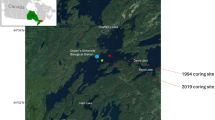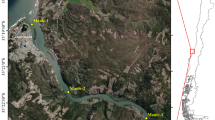Abstract
Ecological and paleoecological studies from the Patuxent River mouth reveal dynamic variations in benthic ostracode assemblages over the past 600 years due to climatic and anthropogenic factors. Prior to the late 20th century, centennial-scale changes in species dominance were influenced by climatic and hydrological factors that primarily affected salinity and at times led to oxygen depletion. Decadal-scale droughts also occurred resulting in higher salinities and migration of ostracode species from the deep chanel (Loxoconcha sp.,Cytheromorpha newportensis) into shallower water along the flanks of the bay. During the 19th century the abundance ofLeptocythere nikraveshae andPerissocytheridea brachyforma suggest increased turbidity and decreased salinity. Unprecedented changes in benthic ostracodes at the Patuxent mouth and in the deep channel of the bay occurred after the 1960s whenCythermorpha curta became the dominant species, reflecting seasonal anoxia. The change in benthic assemblages coicided with the appearance of deformities in foraminifers. A combination of increased nitrate loading due to greater fertilize use and increased fresh-water flow explains this shift. A review of the geochemical and paleoecological evidence for dissolved oxygen indicates that seasonal oxygen depletion in the main channel of Chesapeake Bay varies over centennial and decadal timescales. Prior to 1700 AD, a relatively wet climate and high freshwater runoff led to oxygen depletion but rarely anoxia. Between 1700 and 1700, progressive eutrophication occurred related to land clearance and increased sedimentation, but this was superimposed on the oscillatory pattern of oxygen depleton most likely driven by climatological and hydrological factors. It also seems probable that the four-to five-fold increase in sedimentation due to agricultural and timber activity could have contributed to an increased natural nutrient load, likely fueling the early periods (1700–1900) of hypoxia prior to widespread fertilizer use. Twentieth-century anoxia worsened in the late 1930s–1940s and again around 1970, reaching unprecedented levels in the past few decades. Decadal and interannual variability in oxygen depletion even in the 20th century is still strongly influenced by climatic processes influencing precipitation and freshwater runoff.
Similar content being viewed by others
Literature Cited
Adelson, J. M., G. R. Helz, andC. V. Miller. 2001. Reconstructing the rise of recent coastal anoxia; molybdenum in Chesapeake Bay sediments.Geochemica et Cosmochemica Acta 65: 237–252.
Boicourt, W. C. 1992. Influences of circulation processes on dissolved oxygen in the Chesapeake Bay, p. 7–59.In D. E. Smith, M. Leffler, and G. Mackiernan (eds.), Oxygen Dynamics in the Chesapeake Bay. Maryland Sea Grant, College Park, Maryland.
Boynton, W. R., J. H. Garber, R. Summers, andW. M. Kemp. 1995. Inputs, transformations, and transport of nitrogen and phosphorus in Chesapeake Bay and selected tributaries.Estuaries 18:285–314.
Bratton, J. F., S. M. Colman, R. R. Seal, and P. C. Baucom. In press. Isotopic record of nitrogen and carbon cycling in Chesapeake Bay over the last 2700 years and implications for modern oxygen depletion.Geochimica and Cosmochimica Acta.
Brush, G. S. 1984. Patterns of recent sediment accumulation in Chesapeake Bay (Virginia-Maryland, U.S.A.) tributaries.Chemical Geology 44:227–242.
Chesapeake Bay Program. 2002. http://www.chesapeakebay. net/wquality.htm.
Colman, S. M., D. A. Willard, C. W. Holmes, and A. Zimmerman. 2000. Radiocarbon Dating ofMarion-Dufresne cores MD99-2204, 2207, and 2209, Chesapeake Bay, ch. 6.In T. M. Cronin (ed.), Initial Report on IMAGES V Cruise of theMarion-Dufresne to the Chesapeake Bay June 20–22, 1999, U.S. Geological Survey Open-file Report 00-306. Reston, Virinia.
Cooper, S. R. 1995. Chesapeake Bay watershed historical land use: Impact on water quality and diatom communities.Ecological Applications 5:703–723.
Cooper, S. R. andG. S. Brush. 1991. Long-term history of Chesapeake Bay anoxia.Science 254:992–996.
Cornwell, J. C., D. J. Conley, M. Owens, andJ. C. Stevenson. 1996. A sediment chronology of the eutrophication of Chesapeake Bay.Estuaries 19:488–499.
Cronin, T. M. 1979. Late Pleistocenes marginal marine ostracodes from the southeastern Atlantic Coastal Plain and their paleonevironmental implications.Geographie Physique et Quaternaire 33:121–173.
Cronin, T. M., S. Colman, D. A. Willard, R. Kerhin, C. Holmes, A. Karlsen, S. E. Ishman, andJ. Bratton. 1999a. Interdisciplinary project probes Chesapeake Bay down to the core.EOS 237:240–241.
Cronin, T. M. and S. E. Ishman. 2000. Holocene paleoclimate from Chesapeake Bay based on ostracodes and benthic foraminifera fromMarion-Dufresne core MD99-2209, ch. 9.In T. M. Cronin (ed.), Initial Report on IMAGES V Cruise of theMarion-Dufresne to the Chesapeake Bay June 20–22, 1999. U.S. Geological Survey Open-file Report 00-306. Reston, Virginia.
Cronin T. M., T. Kamiya, G. S. Dwyer, C. D. Vann, S. Schwede, R. H. Wagner, and H. Belkin In press, Ecology and shell chemistry ofLoxoconcha matagordensis. Palaeogeography, Palaeoclimatology, Palaeoecology.
Cronin, T. M., R. S. Wagner, and M. Slattery (eds.). 1999b. Microfossils from Chesapeake Bay sediments: Illustrations and species database. U.S. Geological Survey Open-File Report 99-45. Reston, Virginia.
Cronin, T. M., D. A. Willard, A. Karlsen, S. Ishman, S. Verardo, J. McGeehin, R. Kerhin, C. Holmes, S. Colman, andA. Zimmerman. 2000. Climatic variability in the eastern United States over the past millennium from Chesapeake Bay sediments.Geology 28:3–6.
Darby, D. G. 1965. Ecology and taxonomy of Ostracoda in the vicinity of Sapelo Island, Georgia, p. 1–71.In Four Reports of Ostracode Investigations. University of Michigan, Ann Arbor, Michigan.
Elliott, H. A., R. Ellison, andM. M. Nichols. 1966. Distribution of recent Ostracoda in the Rappahannock estuary, Virginia.Chesapeake Science 7:203–207.
Ellison, R. L. and M. M. Nichols. 1976. Modern and holocene foraminifera in the Chesapeake Bay region, p. 131–151.In C. T. Schafer and B. R. Pelletier (eds.), Ist International Symposium on Benthonic Foraminifera of Continental Margins, Part A. Maritime Sediments Special Publication 1, Halifax, Nova Scotia.
Garbett, E. C. andR. F. Maddocks. 1979. Zoogeography of holocene Cytheracean ostracodes in the bays of Texas.Journal of Paleontology 53:841–919.
Karlsen, A. W., T. M. Cronin, S. E. Ishman, D. A. Willard, C. W. Holmes, M. Marot, andR. Kerhin. 2000. Historical trends in Chesapeake Bay dissolved oxygen based on benthic foraminifera from sediment cores.Estuaries 23:488–508.
Kerhin, R. T., C. Williams, and T. M. Cronin. 1998. Lithologic descriptions of piston cores from Chesapeake Bay, Maryland. U.S. Geological Survey Open-File Report 98-787. Reston, Virginia.
King, C. E. andL. S. Kornicker. 1970. Ostracoda in Texas bays and lagoons: An ecologic study.Smithsonian Contributions to Zoology 24:1–92.
Malone, T. C. 1991. River flow, phytoplankton production and oxygen depletion in Chesapeake Bay, p. 83–93.In R. V. Tyson and T. H. Pearson (eds.), Modern and Ancient Continental Shelf Anoxia. Geological Society Special Paper 58. London, U.K.
Malone, T. C. 1992. Effects of water column processes on disolved oxygen, nutrients, phytoplankton and zooplankton, p. 61–112.In D. E. Smith, M. Leffler, and G. Mackiernan (eds.), Oxygen Dynamics in the Chesapeake Bay. Maryland Sea Grant, College Park, Maryland.
Schweitzer, P. N. andG. P. Lohman. 1990. Life-history and the evolution of ontogeny in the ostracode genusCyprideis.Paleobiology 16:107–125.
Seliger, H. H. andJ. A. Boggs. 1988. Long-term pattern of anoxia in the Chesapeake Bay, p. 570–583.In M. P. Lynch and E. C. Krome (eds.), Advances in Chesapeake Bay Research, Proceedings of a Conference (Baltimore, Maryland. March 29–31, 1988). Chesapeake Research Consortium, Solomons, Maryland.
Stahle, D. W., M. K. Cleaveland, D. B. Blanton, M. D. Therrell, andD. A. Gay. 1998. The lost colony and Jamestown drought.Science 280:564–567.
Taft, J. L., W. R. Taylor, E. O. Hartwig, andR. Loftus. 1980. Seasonal oxygen depletion in Chesapeake Bay.Estuaries 3: 242–247.
Tressler, W. L. and E. M. Smith. 1948. An ecological study of seasonal distribution of Ostracoda, Solomons Island, Maryland, region. Chesapeake Biological Laboratory Publication No. 71. Solomons Island, Maryland.
Tyler, M. A. andH. H. Seliger. 1986. Flow-induced variation in transport and deposition pathways in the Chesapeake Bay: The effect on phytoplankton dominance and anoxia, p. 161–175.In D. A. Wolfe (ed.), Estuarine Variability. Academic Press, Orlando, Florida.
Wall, D. andB. Dale. 1973. Paleosalinity relationships of dinoflagellates in the late quaternary of the Black Sea—A summary.Geoscience and Man 7:95–102.
Willard, D. A., T. M. Cronin, andS. Verrardo. 2003. Late holocene climate and ecosystem variability from Chesapeake Bay sediment cores.The Holocene 13:201–214.
Williams, R. B. 1966. Recent marine podocopid Ostracoda of Narragansett Bay, Rhode Island. University of Kansas Paleontological Contributions Paper 11:1–36. University of Kansas Publications, Lawrence, Kansas.
Zimmerman, A. R. andE. A. Canuel. 2000. A geochemical record of eutrophication and anoxia in Chesapeake Bay sediments: Anthropogenic influence on organic matter composition.Marine Chemistry 69:117–137.
Author information
Authors and Affiliations
Corresponding author
Rights and permissions
About this article
Cite this article
Cronin, T.M., Vann, C.D. The sedimentary record of climatic and anthropogenic influence on the Patuxent estuary and Chesapeake Bay ecosystems. Estuaries 26, 196–209 (2003). https://doi.org/10.1007/BF02695962
Received:
Revised:
Accepted:
Issue Date:
DOI: https://doi.org/10.1007/BF02695962




